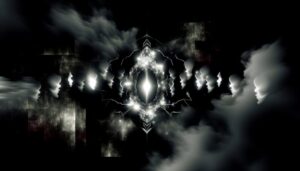How Does the Eye in the Sky Symbolize Meaning Across Cultures?
The 'Eye in the Sky' symbol, often seen as the All-Seeing Eye, signifies divine omniscience and perpetual vigilance. Its roots trace back to the Eye of Horus in Ancient Egypt, representing protection and royal power.
In Freemasonry, it embodies moral vigilance and ethical conduct. This symbol permeates various religious traditions, symbolizing spiritual insight and enlightenment, such as the Eye of Providence in Christianity.
Additionally, modern interpretations in art and media reflect themes of surveillance and existential introspection. The psychological impact of the symbol underscores a sense of being constantly watched.
For a deeper understanding, explore the intertwined layers of its historical and contemporary significance.

Key Takeaways
- The Eye in the Sky symbol represents divine omniscience and perpetual vigilance.
- It symbolizes protection, wisdom, and moral oversight in various cultural contexts.
- In Freemasonry, it signifies ethical conduct and divine guidance.
- The symbol critiques the omnipresence of surveillance and technology in modern art.
- It evokes psychological effects such as increased stress and feelings of being observed.
Ancient Egyptian Origins
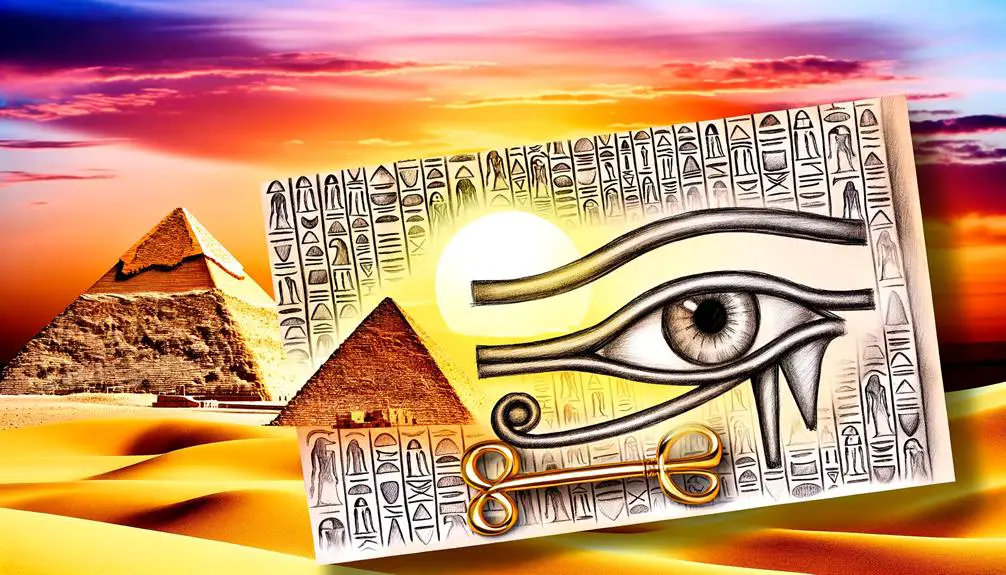
In ancient Egyptian culture, the Eye of Horus symbolized protection, royal power, and good health. It served as a potent emblem that permeated religious and societal frameworks. This symbol, also known as the 'Wadjet,' derived from the mythological narrative in which Horus, the sky god, lost his eye during a battle with Set, the god of chaos. The eye was subsequently restored, signifying healing and wholeness.
Used extensively in amulets and funerary art, the Eye of Horus was believed to safeguard the wearer from malevolent forces and guarantee safe passage to the afterlife. Its widespread application underscores its integral role in expressing the Egyptians' spiritual beliefs and their emphasis on divine protection and cosmic order.
Symbolism in Freemasonry
In Freemasonry, the All-Seeing Eye serves as a potent symbol of divine omniscience, reflecting the fraternity's emphasis on moral vigilance and ethical conduct.
This emblem, tracing its origins back to ancient civilizations, underscores a universal watchfulness that transcends cultural and temporal boundaries.
All-Seeing Eye Significance
The All-Seeing Eye, often depicted within a triangle and surrounded by rays of light, serves as a profound symbol in Freemasonry, representing divine omniscience and the perpetual vigilance of a higher power over humanity. This emblem, known as the Eye of Providence, underscores several key tenets of Masonic philosophy:
- Divine Insight: Symbolizes the omnipotent gaze of the Supreme Being.
- Moral Rectitude: Encourages ethical behavior and integrity among Freemasons.
- Guidance: Acts as a reminder of spiritual oversight and direction.
- Unity: Represents the interconnectedness of all members under a shared divine watch.
- Wisdom: Embodies the pursuit of knowledge and enlightenment.
Masonic Emblem Origins
Tracing back to the early days of Freemasonry, Masonic emblems have always played a pivotal role in conveying the order's rich tapestry of symbolic meanings and philosophical tenets. These emblems, such as the square and compass, the trowel, and the all-seeing eye, serve not merely as decorative motifs but as profound allegories reflecting the moral and ethical guidelines of the brotherhood.
Rooted in the operative stonemasons' guilds of medieval Europe, these symbols evolved to encapsulate esoteric wisdom and universal truths. The all-seeing eye, in particular, symbolizes divine watchfulness and enlightenment, bridging the material and spiritual domains. Through these emblems, Freemasonry imparts lessons on integrity, fraternity, and the pursuit of knowledge, reinforcing its enduring philosophical heritage.
The All-Seeing Eye
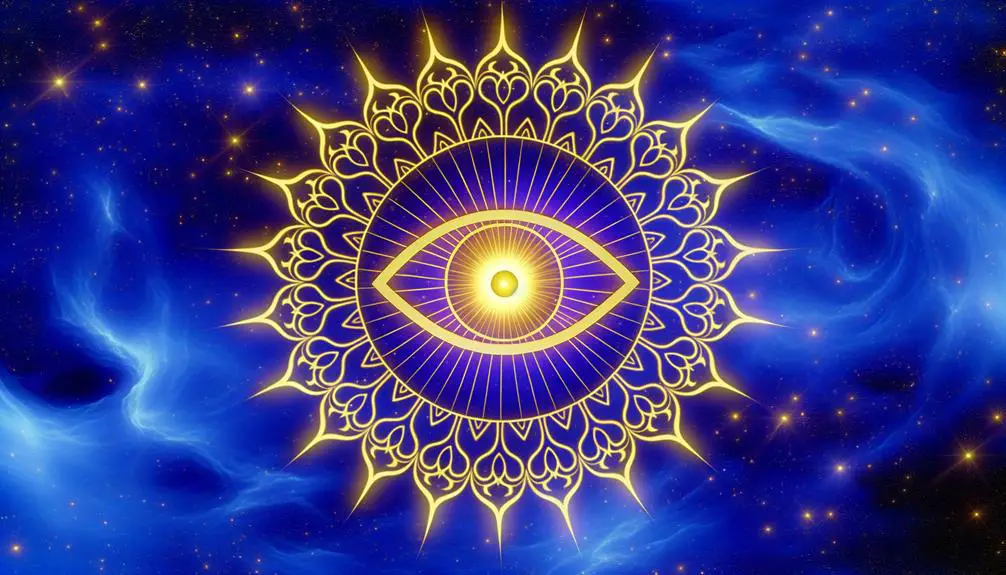
Often associated with divine omniscience, the All-Seeing Eye serves as a powerful symbol in various cultural and religious contexts, encapsulating themes of surveillance, protection, and enlightenment. This symbol, sometimes depicted within a triangle, suggests an ever-watchful presence that transcends human limitations. Its interpretations are manifold:
- Spiritual Insight: Represents the divine ability to perceive all.
- Moral Oversight: Connotes ethical vigilance and accountability.
- Protective Emblem: Seen as a safeguard against malevolence.
- Wisdom and Knowledge: Symbolizes the pursuit of ultimate truth.
- Unity: Frequently linked to the interconnectedness of all beings.
The All-Seeing Eye remains a potent emblem, inviting contemplation on the nature of perception and the unseen forces that govern human existence.
Influence in Art
The 'Eye in the Sky' symbol has profoundly influenced art, from its rich allegorical use in Renaissance masterpieces to its modern reinterpretations in contemporary media.
Within surrealism, the symbol serves as a focal point to question reality and perception, further showcasing its versatility and enduring relevance.
Each artistic period offers unique insights into how this emblematic eye reflects cultural and philosophical shifts.
Symbolism in Renaissance Art
Renaissance art, with its intricate use of symbolism, often depicted the 'Eye in the Sky' as a representation of divine omniscience and moral vigilance. This symbol, embedded within the spiritual and philosophical milieu of the period, conveyed profound theological concepts. Artists employed it to illustrate God's watchful presence and the moral order of the universe.
- Divine Surveillance: Emphasizing the omnipresence of God.
- Moral Accountability: Instilling a sense of ethical responsibility.
- Hierarchical Order: Reflecting the universe's structured nature.
- Artistic Innovation: Blending realism with allegory.
- Philosophical Depth: Engaging viewers in contemplation of higher truths.
This symbolic representation not only enriched the visual impact of artworks but also invited viewers to engage deeply with theological and moral themes.
Modern Interpretations in Media
In contemporary media, the 'Eye in the Sky' symbol has evolved to reflect themes of surveillance, privacy, and the pervasive presence of technology in modern society. This shift highlights a growing cultural anxiety around the omnipotence of digital entities, from government agencies to corporate giants.
Artists and filmmakers often employ this symbol to critique the erosion of personal freedoms and the omnipresent gaze of technology. For example, in dystopian narratives, the 'Eye in the Sky' underscores a society under constant watch, questioning the balance between security and privacy.
Additionally, visual artists integrate this symbol to evoke introspection about the human condition in an age where data is both a tool and a weapon. This modern interpretation provides a nuanced commentary on our evolving digital landscape.
Surrealism and the Eye
Building on the anxiety surrounding surveillance in modern media, surrealism in art has long employed the motif of the eye to explore deeper psychological and existential themes. This symbolic representation often delves into the subconscious, reflecting inner fears, desires, and the omnipresence of an observing force.
The eye, in surrealist works, transcends mere physicality to become a window into the soul and a mirror of societal anxieties.
- Salvador Dalí: Utilized eyes to symbolize paranoia and illusion.
- René Magritte: Featured eyes to challenge perceptions of reality.
- Max Ernst: Embedded eyes in landscapes, invoking omnipresence.
- Leonora Carrington: Employed eyes to convey mystical, otherworldly visions.
- Man Ray: Used fragmented eyes to explore identity and self-perception.
These artists collectively expanded the narrative of the eye, making it a profound emblem in surrealist art.
Depictions in Media
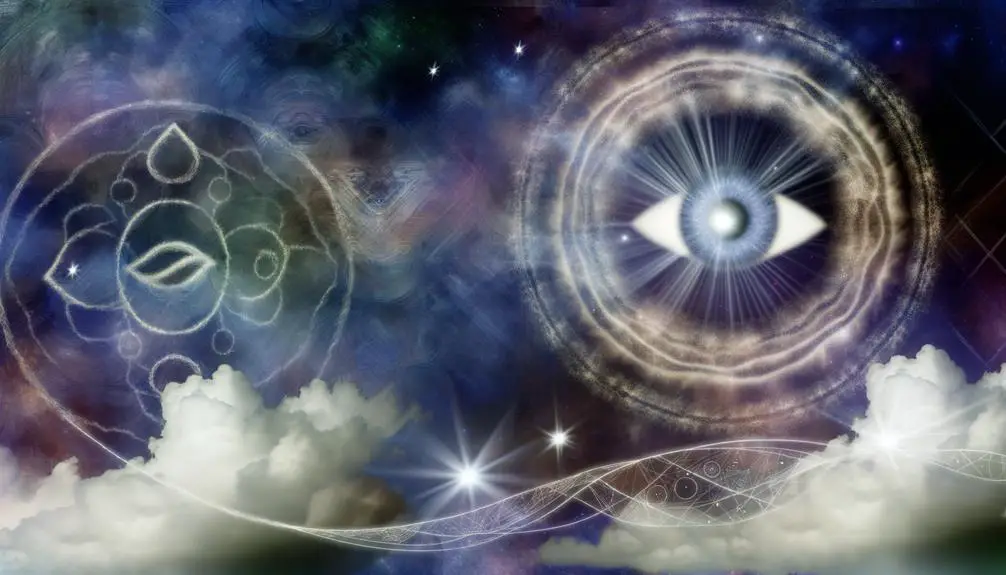
From iconic films like 'The Lord of the Rings' to influential television series such as 'The X-Files,' the Eye in the Sky symbol is frequently employed to evoke themes of surveillance, omniscience, and unseen power.
In 'The Lord of the Rings,' the Eye of Sauron embodies the omnipresent threat, symbolizing an ever-watchful tyranny that instills fear and control.
Conversely, 'The X-Files' utilizes the motif to underscore government surveillance and the quest for hidden truths.
Such media depictions not only heighten narrative tension but also reflect societal anxieties regarding privacy and authority.
Through these portrayals, the Eye in the Sky becomes a powerful narrative device, mirroring broader cultural concerns and fostering a deeper engagement with the storyline.
Religious Connections
Throughout various religious traditions, the Eye in the Sky symbol often signifies divine omnipresence and spiritual vigilance, encapsulating the belief in a higher power that observes and judges human actions. This symbol is steeped in rich theological contexts, reflecting the perception of an all-seeing deity.
Christianity: The Eye of Providence represents God's omnipresence and watchfulness.
Ancient Egypt: The Eye of Horus symbolizes protection, royal power, and good health.
Hinduism: The third eye of Shiva signifies inner vision and spiritual enlightenment.
Islam: The Hamsa hand, often depicting an eye, offers protection against the evil eye.
Buddhism: The Eye of Buddha represents spiritual awakening and the wisdom of seeing beyond the physical world.
These interpretations highlight the symbol's profound spiritual significance across cultures.
Modern Conspiracy Theories
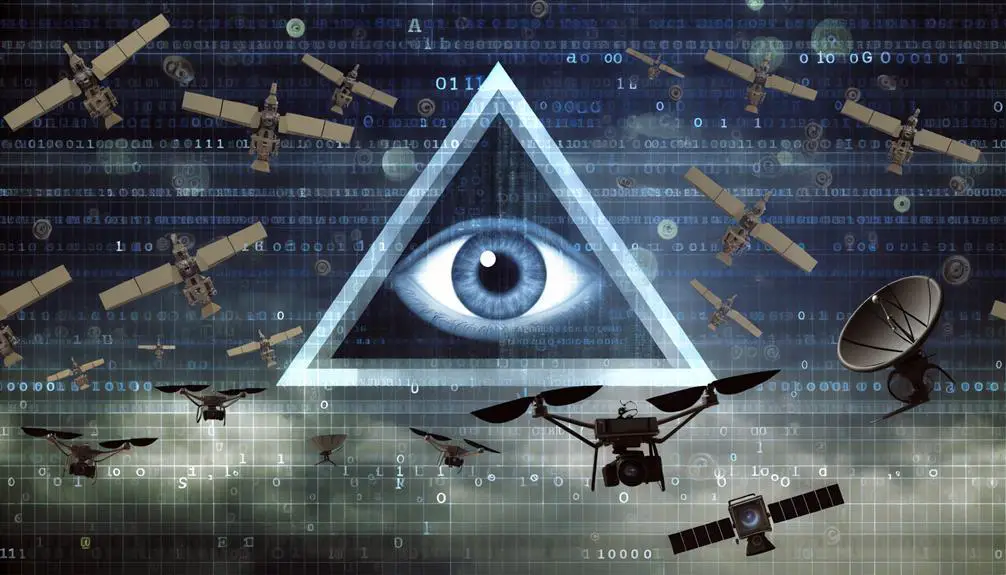
In contemporary discourse, the Eye in the Sky symbol has become a focal point for numerous conspiracy theories, often suggesting pervasive surveillance and covert control by powerful, unseen entities. These theories frequently link the symbol to organizations such as the Illuminati or secret government agencies, positing that it represents a hidden network exerting influence over global events.
The proliferation of digital technology and mass data collection has further fueled these beliefs, engendering a climate of mistrust and suspicion. Analyzing these interpretations reveals a broader societal anxiety about privacy erosion and the reach of authority in the modern era.
The symbol hence serves as a potent metaphor for contemporary fears about surveillance and the loss of individual autonomy.
Cultural Variations
Across diverse cultures, the Eye in the Sky symbol often embodies varying interpretations that reflect unique historical, religious, and sociopolitical contexts. Its multiplicity of meanings showcases humanity's rich tapestry of belief systems and ideological frameworks.
Ancient Egypt:
The Eye of Horus symbolizes protection, royal power, and good health.
Christianity:
The Eye of Providence signifies God's omniscience and divine oversight.
Hinduism:
The third eye on deities like Shiva represents spiritual awakening and insight.
Freemasonry:
It denotes the watchful eye of the Great Architect of the Universe.
Indigenous Cultures:
Some Native American tribes see it as a symbol of insight and vision quest.
These interpretations highlight the symbol's dynamic adaptability across different cultural landscapes.
Psychological Impact
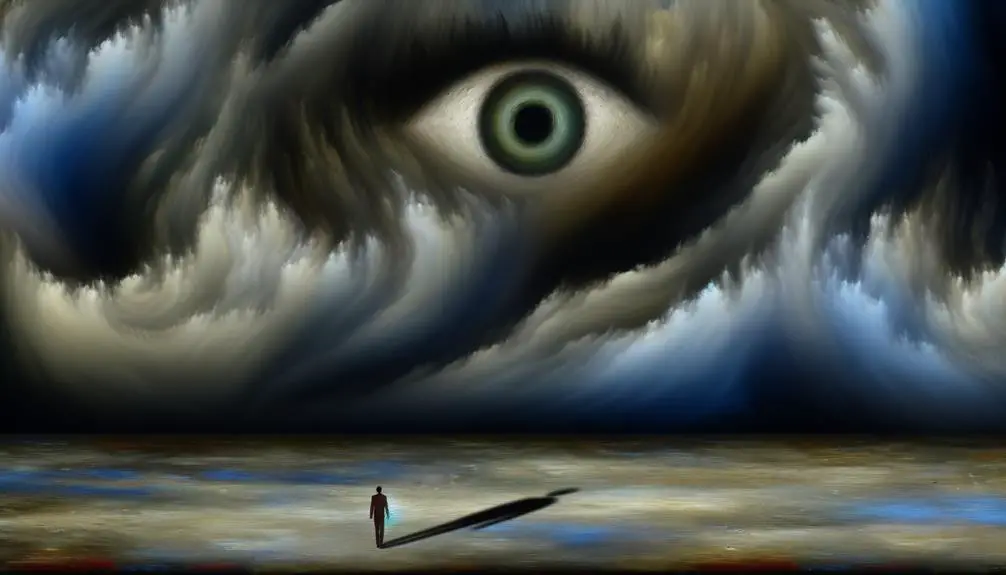
The Eye in the Sky symbol, often evoking a sense of surveillance and omnipresence, can greatly influence an individual's psychological state by instilling feelings of being observed and potentially altering behavior.
This phenomenon, known as the 'panopticon effect,' suggests that the mere perception of surveillance can lead individuals to self-regulate their actions. This heightened self-awareness may result in increased stress and anxiety, as individuals grapple with the notion of constant oversight.
In addition, the symbol can evoke a subconscious drive for conformity, as people aim to meet perceived societal expectations. Consequently, the Eye in the Sky operates not merely as a visual motif but as a powerful psychological trigger, shaping behavior through the implicit suggestion of ubiquitous watchfulness.
Conclusion
The 'eye in the sky' symbol has its origins in ancient Egypt. It has traversed history to embody various meanings in Freemasonry, art, media, and religion. From its depiction as the All-Seeing Eye to its role in modern conspiracy theories, this symbol's cultural variations and psychological impact are profound.
As the saying goes, 'history repeats itself,' highlighting the enduring significance and multifaceted interpretations of this enigmatic emblem across different epochs and societies.






